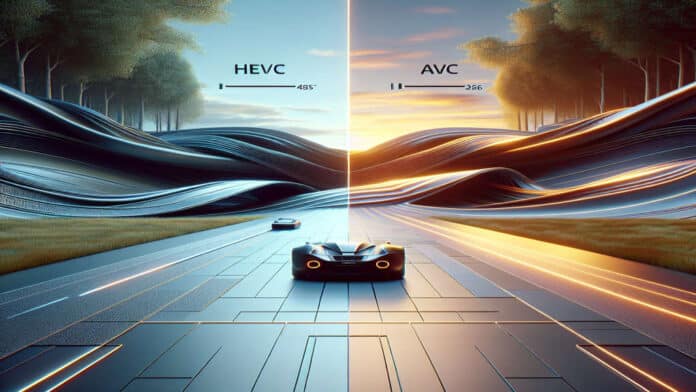Table of Contents
HEVC (H.265) and AVC (H.264) are the industry’s widely used video compression standards. HEVC, also known as High-Efficiency Video Coding, is the successor to AVC, or Advanced Video Coding. Both standards compress and decompress video files, making them smaller and easier to transmit over the Internet.
Main Points
- HEVC (H.265) is the successor to AVC (H.264) and offers better compression and higher image quality.
- AVC (H.264) is an older standard but is still widely used, especially in devices with limited processing power.
- Both standards are essential for streaming, broadcasting, and storing video files efficiently.
Introduction to HEVC (H.265) and AVC (H.264)
High-Efficiency Video Coding (HEVC), or H.265, is a video compression standard designed to improve video quality and reduce the bandwidth needed. In terms of compression efficiency, it offers significant improvements over its predecessor, Advanced Video Coding (AVC) or H.264, which translates to higher-quality video at lower bit rates.
Critical differences between HEVC and AVC include:
- Compression Efficiency: HEVC offers up to 50% better compression than AVC, allowing for higher-quality video at the same bit rate.
- Resolution Support: HEVC supports resolutions up to 8192×4320, while AVC is limited to 4096×2304.
- Improved Parallel Processing: HEVC enables better parallel processing, making it more suitable for multi-core processors and parallel computing architectures.
Technical Comparison of HEVC (H.265) and AVC (H.264)
For video compression, HEVC (H.265) and AVC (H.264) are two widely used standards, each with its strengths and weaknesses. The best choice depends on your specific needs.
Compression Efficiency
HEVC offers significantly better compression efficiency compared to AVC, allowing for higher-quality video at lower bitrates. This is especially important for 4K and 8K video content, where file size and bandwidth are critical.
Complexity and Processing Power
HEVC requires more computational power for encoding and decoding than AVC, making it less suitable for devices with limited processing capabilities. However, advancements in hardware have made HEVC more accessible in recent years.
Compatibility and Adoption
While HEVC offers superior compression, AVC’s wider adoption and support across various devices and platforms make it a more practical choice for reaching a larger audience without sacrificing compatibility.
| Aspect | HEVC (H.265) | AVC (H.264) |
|---|---|---|
| Compression Efficiency | High | Moderate |
| Complexity | High | Moderate |
| Compatibility | Limited | Widespread |
Applications and Implementations of HEVC (H.265) and AVC (H.264)
High-Efficiency Video Coding (HEVC) and Advanced Video Coding (AVC) are the industry’s widely used video compression standards. HEVC, also known as H.265, provides higher-quality video at lower bitrates, making it ideal for 4K streaming, video conferencing, and digital cinema applications. On the other hand, AVC, or H.264, is still commonly used in a wide range of applications such as broadcast television, video streaming, and video surveillance.
HEVC (H.265) Applications
HEVC is widely implemented in various applications because it delivers high-quality video at lower bitrates. One of the primary applications of HEVC is in 4K streaming, which enables the delivery of ultra-high-definition video over bandwidth-limited networks. HEVC is also used in video conferencing systems, allowing for higher-resolution video communication without significantly increasing bandwidth requirements. Furthermore, HEVC has found its place in the digital cinema industry, enabling the distribution of high-quality content while optimizing storage and bandwidth usage.
AVC (H.264) Implementations
AVC (H.264) remains a dominant video compression format despite the emergence of HEVC. It remains a popular choice for broadcast television, as it balances video quality and bandwidth efficiency. Video streaming platforms rely heavily on AVC, particularly for content outside ultra-high-definition formats. Moreover, AVC is extensively utilized in video surveillance systems, offering efficient video compression while maintaining the necessary image quality and detail level.
HEVC and AVC have their strengths and applications, and the choice between them depends on the specific requirements and constraints of a particular use case.
Efficiency and Compression Performance of HEVC (H.265) vs. AVC (H.264)
Regarding video compression, the efficiency and performance of encoding standards play a crucial role in delivering high-quality content while minimizing file sizes. This article will compare the efficiency and compression performance of two popular video codecs: HEVC (H.265) and AVC (H.264).
Encoding Efficiency
The HEVC standard, also known as H.265, offers superior encoding efficiency compared to the older AVC (H.264) standard. It can achieve up to 50% bitrate savings for the same visual quality, making it ideal for high-resolution and high-frame-rate videos.
Compression Performance
HEVC provides enhanced compression performance, especially for ultra-high-definition videos. Its advanced encoding techniques, such as larger block sizes and more efficient prediction algorithms, result in significant file size reductions without compromising visual quality.
Comparison Table
| Parameter | HEVC (H.265) | AVC (H.264) |
|---|---|---|
| Encoding Efficiency | Superior | Good |
| Compression Performance | Enhanced | Standard |
Overall, HEVC (H.265) outperforms AVC (H.264) in terms of encoding efficiency and compression performance, making it the preferred choice for delivering high-quality video content with reduced file sizes.
Bitrate and Quality Analysis: HEVC (H.265) versus AVC (H.264)
When it comes to video compression, the choice between High-Efficiency Video Coding (HEVC) and Advanced Video Coding (AVC) can significantly impact bitrate and quality. In recent years, HEVC has emerged as a more efficient option, offering higher quality at lower bitrates compared to AVC.
The Advantages of HEVC
HEVC, also known as H.265, utilizes more advanced compression techniques, allowing for better video quality at the same bit rate as AVC. This means video content encoded with HEVC will have more detail and clarity, making it ideal for high-definition and 4K content.
Furthermore, HEVC also significantly reduces bitrate without sacrificing quality, making it more efficient for streaming and storage. This is particularly important in today’s media landscape, where bandwidth and storage are valuable resources.
The Drawbacks of AVC
While AVC, also known as H.264, has been the standard for video compression for many years, its limitations are becoming more apparent as technology advances. The bitrate required for high-quality video with AVC is often higher than HEVC, resulting in larger file sizes and increased bandwidth usage.
Additionally, AVC may need help maintaining optimal quality for high-definition and 4K content, leading to a less immersive viewing experience for audiences.
In conclusion, the HEVC codec offers a clear advantage over AVC in bitrate and quality, making it the preferred choice for modern video compression.
Future Prospects and Developments in HEVC (H.265) and AVC (H.264)
As technology advances, the prospects and developments in HEVC (H.265) and AVC (H.264) are of great interest to industry professionals and consumers alike. The ongoing research and innovation in video compression technologies point towards significant efficiency, quality, and flexibility improvements.
HEVC (H.265)
The future of HEVC (H.265) looks promising, with ongoing efforts to enhance its coding efficiency and support for higher resolutions, frame rates, and dynamic range. With the increasing demand for high-quality video content, HEVC is expected to be pivotal in delivering superior visual experiences while optimizing bandwidth utilization.
AVC (H.264)
Although HEVC is gaining traction, AVC (H.264) remains prevalent in various applications and devices. The future developments in AVC focus on optimizing its performance for specific use cases, ensuring compatibility, and extending its lifespan amidst the transition to HEVC.
The prospects of HEVC (H.265) and AVC (H.264) demonstrate a continued commitment to advancements in video compression technologies, catering to the evolving needs of the industry and consumers.



